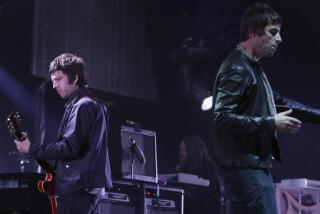Ticket Sellers Offer Speed but Little Choice
- Share via
Imagine a system that sells theater seats over the phone and charges several dollars extra but won’t tell buyers where they’ll sit, that accepts only cash at store outlets and still has so many customers it can sell out a 70,000-seat rock concert in a couple of hours.
That’s today’s ticketing by computer, most often provided by one of two big nationwide companies. Ticketron, 20 years old, estimates that its system sells $1 billion worth of tickets annually. Ticketmaster, competing since 1982, says its system sells $600 million worth.
They’re not competing for consumers but for the facilities that house events or their producers. The ticketing contracts are bid on the basis of service and accounting, equipment and machinery, the technological capabilities of their computers and, of course, money--who gets what from each ticket sale. “Everything gets negotiated,” says Richard Beatty, vice president of marketing for New York-based Ticketron.
System Offers Control
Superficially, all ticket systems are similar, selling tickets both over the phone and at store outlets (often record or department stores) and saving patrons a trip to the box office. Usually a ticket company gets not just an allocation of tickets for an event but access to the full inventory of seats: Even the facility’s box office, manned by its own personnel, plugs in to the system’s computer. “It’s the same principle as selling airline reservations,” says Ticketmaster Chairman Fred Rosen in Los Angeles.
The consumer--usually limited to six tickets per order to discourage scalpers--pays the ticket’s face value plus a service and/or handling charge that goes to the ticket company. The company may also get a piece of the ticket price.
The most obvious advantage is speed. When tickets for a November U2 concert went on sale in Los Angeles, Ticketmaster handled almost 900 tickets a minute--one sale a minute (average six tickets) at each of 120 Southern California store outlets and one every 2 1/2 minutes at 80 phone stations. In the first 7 minutes, 6,000 tickets were sold, 21,000 in the first half hour and in 2 1/2 hours, all 70,000 seats were gone.
The other advantage is control, Beatty says, over any sales “that require the reservation of a particular time and space--the maximum number of people on an Alcatraz tour ferry, the number of people in a museum at one time, even golf tee-off times.” Ticket sales themselves are more orderly: “When you’re dealing with lots of people,” Rosen says, “it’s easier to control crowds by dispersing them than by convening everybody at one place.”
Appearance Counts
The consumer also saves time and effort but may give up choice. Generally, callers can neither request nor approve a given seat. The computer is programmed to offer the “next-best available” seat at a price level, and phone operators won’t say where it is. The programmed order is set by the facility, following normal customer preference. “For a concert or Broadway show,” Beatty says, “the closer to the stage, the more attractive, but for dance or films the best seats are usually 10 or 12 rows back because you want a little perspective.” Seats obstructed by columns or overhangs are sold last and clearly marked as obstructed.
The programming usually takes into account what’s good for the facility as well as the consumer. “You want your house to look good,” explains Claire L. Rothman, vice president and general manager of the Forum in Los Angeles. “Dressing the house,” as it’s called, might mean, Rothman says, “freezing every other row in sections that have large blocks of unsold seats” to give the illusion that it’s filled evenly and overall.
The ticket-buyer isn’t always kept totally in the dark. Fine arts patrons, for example, are usually told the section assigned, if not the exact seat--the facility’s wish, ticket vendors say.
For the ticket company, “the primary reason (for not telling) is time,” says Al DeJardin, vice president of Ticketron’s Western region. An exact location “is meaningless if they don’t have a floor plan in front of them,” Beatty says, and difficult to describe and discuss over the phone. (At 900 sales a minute, adds Tom Hogg, Ticketmaster’s West Coast general manager, a U2 customer wouldn’t want to waste time either: “He’ll get a seat but the longer he talks, the farther away.”)
Furthermore, any discussion leaves room for misunderstanding. The phone buyer “could later say, ‘They told me something different,’ ” Hogg says. “With a store outlet, you see what you have before you walk away.”
The consumer’s choice of phone or outlet involves more than seat selection. Phone orders are charged to a credit card, so many higher-priced tickets are phone-ordered. “Kids may not have credit cards,” DeJardin says, “so rock concerts generate lines at record stores.” Store outlets generally accept cash only because, the ticket companies say, stores aren’t willing to spend extra time or pay the card transaction charges levied by banks or American Express. (Box offices, of course, generally take cash or credit cards.)
Reason for Charges
Phone orders also cost more because the phone operation is more expensive. There are operators and equipment and “it’s a longer transaction,” DeJardin says. “There’s more information gat1751478885credit card number--plus doing a credit check.” There are also credit card transaction fees, credit card losses if the number is fraudulent or the cardholder refuses to pay. Finally, there are the costs of mailing or putting tickets on “will call” at a box office.
As a result, a $6 Dodger ticket from Ticketmaster would have a $1.25 service charge at a store outlet, $1.50 over the phone (plus 50 cents per order for handling.) A rock ‘n’ roll ticket would have a $3.50 or $4 service charge (plus $1.25 handling charge per order), compared to $2 to $2.50 at a store outlet. (Ticketmaster is generally a little more expensive than Ticketron).
Nevertheless, a third of Ticketron’s business now goes over its “Teletron” phones, and Ticketmaster finds phone business growing almost twice as fast as its outlet volume--40% a year, Rosen says, compared to 25%. “Time,” Rosen says sagely, “is money”--apparently to consumers as well as to ticket sellers.
More to Read
Inside the business of entertainment
The Wide Shot brings you news, analysis and insights on everything from streaming wars to production — and what it all means for the future.
You may occasionally receive promotional content from the Los Angeles Times.










